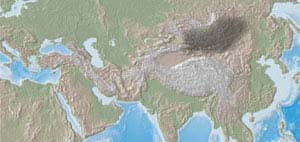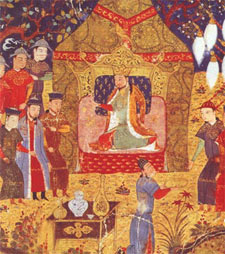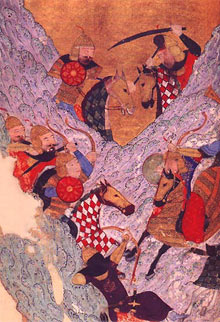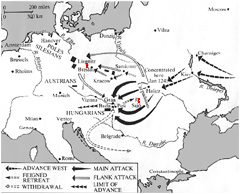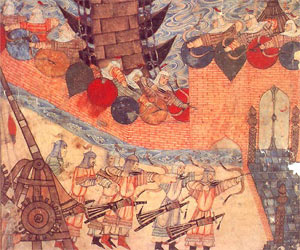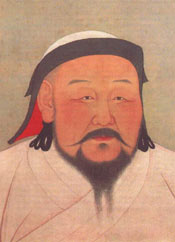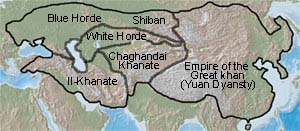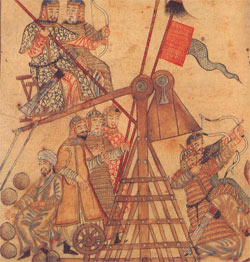|
Heavy Cavalry of the Imperial Guards
|
Introduction
Perhaps no empire in history has risen so spectacularly as that of the Mongols. In less than 80 years, a band of warriors originally comprised of several men grew to an empire that encompassed all from the Pacific Ocean to the Danube River. This story is about one of the most dramatic series conquests in history and how it was the Mongols themselves who shattered their own invincibility.
In the 12th century, various Turkic and Mongol-Tungusic tribes roamed the steppes of Mongolia. One of these tribes was the Mongols. Around the 1130, the Mongols emerged as a powerful tribe, defeating neighboring nomads and forcing the Jin Empire of Northern China to pay tribute. However, the glory was short lived. In 1160, the Mongol Kingdom was shattered, having been defeated by the neighboring Tartars tribe. The Mongol clans (divisions within a tribe) became disunited and fought amongst themselves for what little there was.
The leader of the Mongol Kiyad Sub-Clan was Yesugei, who happened to be a descendant of a Khan (chieftain) of the former Mongol Kingdom. In 1167, Yesguei and his wife had a son named Temujin, the one who would become Genghis Khan. When Temujin was nine years old, his father was poisoned by Tartar chiefs. Since he was much to young to rule, his clansmen deserted him. Temujin and his family (7 people total) moved to the most desolate areas of the steppes, eating roots and rodents for living. He had many great adventures, ranging from chasing horse thieves to being captured by enemies. When Temujin was 16, the Merkid Tribe attacked his family and captured his wife. With an army of five men, Temujin could not retaliate on his own, so he turned to one of his father's old friends, Toghrul Khan of the Kereyid Tribe, who in turn, also enlisted a Mongol coalition leader, Jamugha. Together they defeated the Merkids and Temujin recovered his wife. Temujin quickly took advantage of his powerful allies, particularly Jamugha, who was also happened to be a Mongol and a childhood friend of his, and became a notable figure on the steppes. Temujin and Jamugha took control over most of the Mongol Clans, but that was not enough for Temujin.
According to the Secret History of the Yuan Dynasty, one day while Temujin and Jamugha were riding at the front of the Mongols, Temujin decided to "keep going" while Jamugha stopped to pitch tent. Temujin broke up with Jamugha and the Mongols were split into two groups. Hostilities soon broke out between the two parties. In a clash over a minor event, Temujin was defeated and was forced into exile. However, Temujin returned ten years later and reestablished his position. From there, he embarked on a conquest of the Mongolia that lasted several years. Unfortunately, the details are too great to be perused in this article. In short, by 1204 Temujin had subjugated all that opposed him. He defeated the Tartars, the Kereyids tribe under Toghrul Khan (who eventually betrayed him), the Naimans the Merkids, and Jamugha's Mongol clans
The Empire by 1204
In 1206, Temujin held a great Khuriltai (assembly) on the banks of the Onon River. There, he took the title Chingis Khan. The name Chingis Khan is commonly referred to as Genghis Khan. However, "Genghis" is actually a corrupted variation, and thus for accuracy reason, he will be referred to as "Chingis" Khan. During the Khuriltai of 1206, Chingis Khan decreed the structure and laws for his new Empire. To ensure stability and cooperation between people of the tribes that he united, Chingis Khan installed a military superstructure to integrate all the peoples of his Empire. The population was divided into units responsible for maintaining a certain amount of warriors ready at any given time, thus overriding previous tribal organizations. Furthermore, he decreed many specific laws and created an efficient administrative hierarchy. Chingis Khan created the most advanced government of any steppe nation up to that time. His horde would soon prove to be the most disciplined, the most powerful and the most feared army to ride from the steppes.
|
The Khuriltai of 1206. From a manuscript by Rashid ad-Din
|
The War in Northern China
|
Mongol horsemen battle Jin
Warriors in the Mountains
|
Chingis Khan became emperor of "all who lived in felt tents," but his dreams was to conquer the world. First, he led his men in a series of campaigns against the Xi Xia Empire in western China. In 1209, the Xi Xia capital was threatened, but the Mongols were satisfied with tribute after their camp was unexpectedly flooded. It must be understood that the Mongols were still more interested in and tribute plunder rather than to capture cities. However, as the Empires in China discontinued to pay tribute once the Mongols withdraw, the raids soon turned into conquest.
In 1211, Chingis Khan took 65,000 men and marched against the Jin Empire of Northern China. With the help of the Ongguts, a people who lived on the Jin's northern border, Chingis Khan easily passed through the defenses and marched into Jin territory. He continued a trail of plunder until he met a large force of around 150,000 men, which he defeated. Chingis split his army and launched a multiple pronged attack on the Jin. He and his generals dealt several blows against the Jin, including capturing the strategic Juyong pass. Unfortunately, Chingis was wounded during a siege and withdrew to Mongolia. Subsequently, Jin forces began to recapture territories loss to the Mongols.
In 1213, the Mongols returned after learning that the Jin had refortified their locations. Chingis divided his army into three parts, one under command by himself and the other two, under his sons. The three Mongol armies devastated the Jin Empire, and by 1214, most of the area north of the Huang He (Yellow river) was in Mongol hands. One exception was the city of Chungdu, capital of the Jin Empire. Like other nomadic armies, Chingis Khan's Mongol hordes were entirely cavalry, and the weakness of cavalry forces was the lack of ability to capture fortifications. Chingis realized this weakness and was quick to capture Chinese siege engineers to learn siege tactics. Despite so, Chungdu withstood the Mongols' assaults. Chingis's men became short on supplies and were ravaged by plague, but he tenaciously continued the siege. Accounts describe that every tenth man was sacrificed to be fed to the others. But the siege went on for so long that Chingis had to personally abandon the campaign. He then placed his general Mukali in charge. The Mongols finally entered the city in 1215, but by then, the Jin capital had already been moved south to Kai-feng.
The First Move West - the Conquest of the Kwarazm-Shah Empire
Chingis lost interest in the war in China and instead, turned his attention towards the west. In 1218, he sent his general Chepe westward and conquered the Kara Khitai Empire. But the real issue was with the huge Kwarazmian Empire in Perisa. Hostilities broke out when the Kwarazm Shah attacked a Mongol caravan and humiliated Chingis's ambassadors by burning their beards. Since Chingis sent the ambassadors for the purpose of making peace, he was outraged. Chingis prepared for the largest operation he had yet performed and assembled a force that totaled around 90-110,000 men. The total numerical strength of the Kwarazm shah was two to three times greater, but Chingis' army was better disciplined, and most of all, better led.
In 1219, Chingis's sons Chaghadai and Ogedei set out to attack the city of Utar located east of the Aral Sea. Meanwhile, Chingis' general, Chepe, marched southwestward to protect the left flank during the operation. The main attack, however, was led by Chingis Khan himself, who along with general Subedei, marched through the Kizil Kum desert and outflanked the Kwarazmiam forces. The plan was that the Kizil Kum desert was considered impractical to cross, which made it a great opportunity to surprise the enemy. Chingis and his army disappeared into the desert and suddenly, out of nowhere, he appeared at the city of Bokhara. The city garrison was stunned, and was quickly defeated. Next, Chingis marched towards Samarkand, capital of the Kwarazmian Empire. The magnificent city was heavily fortified and had a garrison of 110,000 men, which vastly outnumbered Chingis' besieging army. The city was expected to be able to hold out for months, but on March 19, 1220 its walls were breached in just ten days. After the fall of Samarkand, the Mongols overran much of the Empire. The destruction was profound. Cities were leveled and populations were massacred. At the city of Merv, accounts described an execution of 700,000. At Samarkand, women were raped and sold into slavery. Devastation was so great that the Kwarazmian Empire itself was nearly wiped away from history. The conquest of the Kwarazm also created another remarkable event. After his defeat, the Kwarazm Shah fled west and Subedei followed in pursue with a force of 20,000 men. The Kwarazm Shah died, however, but Subedei went further. He brought his army north and defeated a heavily outnumbering Russian and Cuman army at the Khalka River. He went further and attack the Volga Bulgars before returning back. As said by the famed history Gibbons, Subedei's expedition was one of the most daring expeditions in history, unlikely to be repeated ever again.
|
The Campaign in Northern China and
the Conquest of the Kwarazmian Empire.
|
During the entire campaign, the Kwarazm Shah failed to assemble an army to fight the Mongols on the battlefield. The Kwarazm strategy relied on its extensive city garrisons that outnumbered the besieging Mongol armies. This of course, failed in every way. The only well organized resistance against the Mongols came from Jalal ad-Din, who after the fall of Samarkand, organized a resistance force in modern day Afghanistan. At Parwan, he defeated a Mongol force led by one of Chingis' adopted son, making it the only Mongol defeat in the entire campaign. Chingis chases after Jalal ad-Din and destroyed his army at the Indus River. The defeat of Jalal ad-Din meant the consolidation of rule of Transoxania. However, the southern parts of the Kwarazmian Empire were left unconquered and later turned into a collection of Independent states. It is said that the Mongols decided not to advance when the sight of a unicorn demoralized their vanguard.
At the age approaching sixty, Chingis' health was at a decline. He sought the legendary Daoist monk Changchun for the exilir to Immortality. His wish did not come true, as Changchun had no magical exilir, but Chingis praised his wisdom and the two became good friends. Following the meeting with the Daoist monk, Chingis returned to the administration side of his objectives. Unlike Attila the Hun and Alexander the Great, Chingis Khan realized the importance of a smooth succession after his death. Before he completed his conquest of the Kwarazmian Empire, he had already carefully chosen his son Ogedei to be his successor. After Chingis returned to Mongolia to finish establish the administration structure of his empire, all the matters were in good order, except for the Tanguts. The Tangut Xi Xia Empire had long been defeated by the Mongols, but became more of a tributary rather than being annexed. However, the Tanguts had stopped complying with terms while Chingis was away. In 1226, Chingis Khan led his army against Xi Xia and captured its capital.
The Death of Chingis Khan
The campaign against the Xi Xia was his last campaign Shortly later in August 1227, Chingis Khan died at the age of 60. The reason remains unsolved, with theories ranging from internal injuries after a hunting accident, to malaria, to prophecies of the Tanguts.
At his death, the Mongol Empire stretched from the Yellow Sea to the Caspian Sea. No other empire in history has seen such an extraordinary expansion in the lifetime of one man. Although Chingis Khan brought much destruction in his conquests, it is clear that he did not intend to commit mass genocide like that of Hitler, even though the death tolls far exceeded anything in history. Chingis's dream was conquest, and whenever surrender was seen, bloodshed was avoided. He was exceptionally respectful to those who supported him, and it was not uncommon for him to befriend defected enemies. In any case, Chingis was a brilliant military strategiest and an exceptionally gifted leader, making him one of the most intriguing figures in history.
The Great Khan Ogedei
After the death of Chingis, the Mongol Empire was divided into four ulus, each given to his four "main" sons. Although these ulus (inheritances) were politically united in the same empire, they would later serve as the basis of future khanates. As said before, Ogedei had already been chosen by Chingis to be his successor. Two years after Chingis' death, Ogedei was officially proclaimed as the ruler of the Mongol Empire. Ogedei took the title of Khakhan ("Great Khan" or "Khan of Khans"), a title used by rulers of the greatest steppe Empires. Chingis however, never officially used this title. Nonetheless, Ogedei ascended with a smooth transition.With the fall of Kiev, the Mongols were victorious in Russia, pulling off the only successful winter invasion of Russia in history. As the result of the Mongols' sweep into Russia, many groups fled across the border and sought refugee in Hungary. Among these were the Cumans and Kipchaks, who were also nomadic cavalrymen like the Mongols. When Batu Khan learned of this he was furious, because they were "his subjects" and thus were not allowed to escape. Whether or not this was the case, Subedei quickly planned a campaign against Europe. The plan was a two-pronged invasion: A flanking force of 20,000 men would be sent into Poland, while he himself (and Batu) will lead the main force of 50,000 men. On March 1241, Subedei and Batu's force dissolved into the Carpathian Mountains, appearing out of nowhere on the other side. But instead of advancing further into Hungary, the Mongols withdrew. Upon seeing this, the Hungarians became somewhat arrogant, and even dismissed the Cumans and Kipchaks, who were also nomadic cavalrymen much like the Mongols. Meanwhile, the northern army stormed into Poland, laid waste to the countryside, and sacked Cracow. On April 9, a European force led by Duke Henry of Silesia crossed into Poland and challenged the 20,000 strong Mongols. The heavily armored European knights were no match for the quickness of the Mongol horsemen, and consequently were defeated. Meanwhile, King Bela of Hungary realized that the Mongol retreat was feigned, and were now actually closing in. King Bela rode out with a force numbering 60-80,000 men and met the army of Batu and Subedei's at the opposing side of the Sajo River. After an indecisive clash at the bridge of the river,
The "Devil's Horsemen"
|
The Empire at the ascension of Ogedei Khan
|
The first thing one Ogedei's mind was to subjugate the remaining fragments Kwarazem Empire, which was earlier destroyed by Chingis Khan in 1221, but had been later restored in modern day Azerbaijan. This objected was completed in 1231. The next goal was to complete the conquest of the Jin Empire. The Jin Empire had already lost a great deal of territory to Chingis Khan, and later to Mukali, who was assigned by Chingis to take over as commander in the Northern China theatre. But after Mukali's death in 1223, the Jin began to fiercely fight back. In 1231 a large Mongol army led by Ogedei, the renowned general Subedei, and Tolui (Ogedei's brother) set off against the Jin. After a series of setbacks, the Mongols finally stormed the Jin capital of Kai Feng in 1234 with the aid of 20,000 Song Chinese auxilleries, thus ending the great sedentary Empire that oversaw the steppes for over a century.
While the Ogedei was campaigning in the Jin Empire, he had already ordered the construction of an Imperial capital for the Empire. When the city, named Karakorum, was completed in 1235, it stood as the grandest site in Mongolia. (Karakorum had already been founded long ago by Chingis, but was more of an outpost back then rather than a capital.) Although the city did not grow to an impressive size like the cities of China, the city was impressively diverse and multi-cultural flourished with professional craftsmen, as later remarked by the European traveler Rubruck. Ogedei also made several reforms in the government, of them begin an improvement of the postal system (the Yam).
The Invasion of Russia
Although the Mongols had already made contacts with the Russians a decade earlier in 1222, during Subedei's legendary expedition, the Mongols did not establish any permanent government in those lands. When Chingis Khan died, the northwestern territories of the empire were given to his son, Jochi. One of Jochi's sons was Batu Khan, who inherited the westernmost territories of Jochi's ulus. But Batu's land was small and a great part of the land he was "given," was not yet under Mongol control. In the Khuriltai of 1235, Batu showed his intension to bring these lands under Mongol control. This decision would create an extraordinary conquest that in the end, Batu's army would have traveled five thousand miles! Subedei agreed to go with Batu; and in 1237, the two gathered a force that numbered 120,000 men ready to cross the frozen Volga into Russia.
During winter, the Mongols crossed the Volga River, and afterwards, ridding north into the forests to hide their presence. The first major city they came to was Riazan, which fell after a five-day catapult assault. Then they rode north and captured Kolumna, Moscow, and defeated the Grand Duke of Suzdal, the most powerful force in the northern half of Russia. From there the Mongols advanced towards Novgorod. However, the siege was abandoned after the marshes proved too frustrating to travel through. Although Novgorod became one of the only major cities in Russia to avoid the Mongol conquest, they would keep a friendly relation with the Mongols by paying tribute. After the frustration at Novgorod, Batu and Subedei rode south and attacked the city of Kozelsk, which valiantly held off the Mongols and even successfully ambushed a Mongol vanguard - a feat rarely ever been done. Kozelsk held off for seven weeks, and after it finally fell, the entire population was slaughtered in a way so great that the Mongols named it the City of Woe. The last obstacle in Russia was the great city of Kiev, often called the "Mother of all Russian cities". Because Kiev was so important in Eastern Europe, the Mongols even tried to take it undamaged. Prince Michael of Kiev did indeed realize the inevitable capture of Kiev. Unfortunately, he fled, and his second in command was a tenacious officer and decided to resist. When the Mongols did storm the city, the only major structure that was not destroyed was the Cathedral St Sophia.
The Invasion of Europe
|
The Mongol Invasion of Europe
|
With the fall of Kiev, the Mongols were victorious in Russia. Interestingly, this was the only successful large-scale winter invasion of Russia in history. As the result of the Mongols' incursion into Russia, many groups fled across the border and sought refugee in Hungary. Among these were the Cumans and Kipchaks, who were also nomadic cavalrymen like the Mongols. When Batu Khan learned of this he was furious, because they were "his subjects" and thus were not allowed to escape. Whether or not this was the case, Subedei quickly planned a campaign against Europe. The plan was a two-pronged invasion: A flanking force of 20,000 men would be sent into Poland, while he himself (and Batu) would lead the main force of 50,000 men. On March 1241, Subedei and Batu's force dissolved into the Carpathian Mountains, appearing out of nowhere on the other side. But instead of advancing further into Hungary, the Mongols withdrew. Upon seeing this, the Hungarians became somewhat arrogant, and even dismissed the Cumans and Kipchaks, who could've provided valuable cavalry support. Meanwhile, the northern army stormed into Poland, laid waste to the countryside, and sacked Cracow. On April 9, a European force led by Duke Henry of Silesia crossed into Poland and challenged the 20,000 strong Mongols. The heavily armored European knights were no match for the quickness of the Mongol horsemen, and consequently were defeated. Meanwhile, King Bela of Hungary realized that the Mongol retreat was feigned, and were now actually closing in. King Bela rode out with a force numbering 60-80,000 men and met the army of Batu and Subedei's at the opposing side of the Sajo River. After an indecisive clash at the bridge of the river, Subedei brought a contingent south and crossed the river without the Hungarians noticing. When Subedei appeared on the other side, the Hungarians were dumbstruck. Soon Batu broke across the bridge and the Hungarian army was surrounded.
The two major victories by two separate Mongol armies in a period of mere days apart show the brilliancy of Subedei's generalship. In one month, Poland and Hungary were defeated. Days after the victory at Sajo River, (the name of the battle is also known as Mohi) the two Mongol forces joined and laid waste to the remaining Hungarian forces, capturing cities such as Pest. The grand and splendid city of Gran was captured on Christmas day.
By early 1242, when Batu considered to go even farther into Europe, he suddenly received news from Mongolia that the Great Khan Ogedei had died. This news was significant. Batu's concern was the possibility of his personally disfavored Guyuk Khan receiving the title of Great Khan. Since Batu had conquered so much land, the political instability in Mongolia would provide trouble. He decided to return to Russia and politically establish his domains to avoid any trouble. As a result, the Mongol army entirely withdrew from Poland and Hungary.
Europe was abandoned and Batu returned to the north of the Caspian Sea. There, he established his capital at Sarai Batu (Old Sarai), and transformed his "inherited lands" into a kingdom, or Khanate. Batu's Khanate became known as the Blue Horde. Batu's two brothers, Orda and Shiban, who also participated in the campaign also formed their Khanates. Orda's Khanate became known as the White Horde, located east to Batu's Blue Horde. Because Batu and Orda were both member of the Golden Clan, the two Khanates were in reality, depencencies of one another, and became known together under the name of "The Golden Horde". Shiban's Khanate, however, is obscurely known. Although the Khans of the Golden Horde would continue to recognize the superiority of the Great Khan and "remain" as part of the Mongol Empire for four more decades, in reality the Golden Horde (and all the other Khanates that would eventually form), had political independence at will.
The Great Khan Guyuk
Guyuk succeeded as Khakhan (or Kha'an - Great Khan) in 1246. Tensions between Batu and Karakorum soared into heights. Fortunately, Guyuk's died in 1248, just two years after his enthronement. Guyuk's early death prevented a major civil war, but the weakness of the Mongol Empire had been foreshadowed. It would be civil disunity that would ultimately bring the Mongol Empire down. The reign of Guyuk achieved little; let alone the disunity in the Empire that it caused.
The Mongol Crusaders - The Great khan Mongke
The next Khakhan, Mongke, was elected in 1251. Upon begin crowned Khakhan, Mognke announced his ambitions to continue the line of conquests that was halted during Guyuk's reign. The first was to conquer the Song (Sung) Empire, the last of the three pre Chingis Empires in "China" free from Mongol control. This and the long series of campaigns against the Song will be examined later. His other motive was to destroy the presence of the Assasins (Ismailis), who have been threatening the governors of the western provinces, and bring the Abbasid Caliph into submission. Thus, this campaign would travel through Persia and into Mesopotamia and towards the Middle East.
The Mongols had seen a limited incursion into the Middle East when Baiju conquered the Seljuk Sultanate of Rum in 1243. However, further campaigns into Baghdad were canceled at that time due to the instability of the newly acquired Asia Minor and the political troubles in Karakorum. Mongke's proposed expedition, however, was planned to be a great one, and indeed it would live up to its name. While Mongke Khan was to personally lead the attack against the Song, he entrusted his brother, Hulegu, to lead the Mongol "Crusade."
Hulegu's "Crusade"
In 1253, Hulegu departed from Mongolia to begin the largest operation since Batu's invasion of Russia. It was also the most advanced Mongol army yet to campaign, with the latest in world siege weapon technology, and a group of experienced lieutenants. Hulegu's expedition attracted great enthusiasm among Christian communities, including a number of Georgian and Alan volunteers. Hulegu's army marched slowly compared to Mongol standards, taking three years to finally reach Persia. He made his way into Khurasan (region in Persia), annexing the local dynasty in the area. The first of the primary objectives was completed with the capture of the Assassins' (the Hashashins) fortress of Gerdkuh on the south side of the Caspian Sea. Hulegu then advanced west and captured Alamut, forcing the Assassins' Grand Master to surrender.
|
Mongols Besiege a city in the Middle East
|
After the capture of Alamut, Hulegu marched toward the grand prize of Baghdad. The Caliph of Baghdad happened to be an incompetent military commander, one foolishly ignorant of the Mongol threat. When the Caliph decided to prepare for a siege, Hulegu was already closing in. Upon his arrival, a force of 20,000 cavalrymen rode out to confront the Mongols. This force was easily defeated, making the siege inevitable. Baghdad held out for a week until its east walls were breached. On February 13, 1258, the city surrendered and a devastating slaughtered ensued. The treasure was looted, the magnificent mosques were destroyed, and the populated was massacred. (An interesting thing is that all the Christian inhabitants in the city were spared.) Accounts claim a slaughter of 800,000 men. This may have been an exaggeration, as the city was later revitalized to an extent. However, there is no doubt that the greatest city in the Middle East had forever lost its glory and that there is no doubt the fall of Baghdad was one of the greatest blows to Islam.
Egypt is saved
Hulegu then withdrew almost his entire army except a minor force of 15,000 men to his general Kedburka to keep an eye on the horizon. Meanwhile, the Mameluks were expecting the full fury of the Mongols, and gathered a large force of 120,000 men. But Hulegu had already withdrawn. Thus, the Mameluks only met Kedburka's 25,000 (15,000 Mongols and 10,000 allies) men at Ain Jalut. The heavily outnumbered Mongols lost in a battle that has traditionally been exaggerated symbolize the dramatic halt of Mongol expansion. In truth, it was the death of Mongke Khan that really saved Egypt, much like how the death of Ogedei Khan saved Europe.
Mongke's death, Civil war and Kublai Khan
The death of Mongke Khan in 1259 was a significant turning point in the history of the empire. In the West, it meant that Hulegu's campaign was at an end. The political envoironment in the East became unstable, and thus, Hulegu had to settle down to claim his land. Hulegu Khanate in Persia became known as the Il-Khanate. However, there was even more problems. Hulegu's campaing agaisnt the Caliph bitterly angered the Muslim Khan Berke of the Golden Horde. With throne of the Great Khan in vacancy, unable to regulate peace, civil war erupted between Berke and Hulegu. Interestingly, this civil war also forced Berke to abandon his plans to ravage Europe once more.
In the East, two brothers competed fiercely for the throne of the Great Khan. One year after Mongke Khan's death in 1259, Kubilai Khan was elected Khakhan in a Khuriltai. Shortly later, his brother, Ariq Boke, was also elected Khakhan at a rivaling Khuriltai. The civil war lasted until 1264 (parallel to the civil war in the west), when Kubilai was victorious over Ariq Boke, thus becoming the undisputed Khakhan. This civil war had an implied meaning. During the war, Kublai Khan based himself in China while Ariq Boke based himself in Karakorum. Kublai Khan's victory implied that China was becoming more over important to the Empire than Mongolia, symbolizing the sinification of the Mongols in the East.
To the Empire as a whole, these years of the civil war meant an end to cohesion. A bitter divide now existed in the west, and the in the East, the Great Khan became only interested in China. Thus, one may argue that the death of Mongke Khan in 1259 meant the end of the "Mongol Empire", (although the Mongol Empires would continue to thrive invidually). However, because Kublai Khan later became so great of a ruler, some prefer to have the timeframe of the "Mongol Empire" inclusive until the end of Kublai's Reign, who did hold nominal power over the other Khanatse.
Kublai Khan The Conquest of the Song
The conquest of the Song Empire, sometimes called the "true" Chinese dynasty as opposed to the Jurchen-established Jin Dynasty, began during Mongke Khan's reign. The Song Empire was the most formidable and most geographical challenging Empire to conquer due to its tough infastructure and mountainous terrain. While Mongke Khan fought in the north, Kublai Khan (who then had not yet become Khan) took a well-sized force, marched through Tibet, and attacked the Song Empire from the south. His men were eventually depleted, however, and he had to withdraw. However, Mongke Khan was able to pull off a series of success until he fell to disease contacted during war. The death of Mongke Khan and the subsequent civil war between Kublai and Ariq Boke caused a stall in campaigning for four years. In 1268, the Mongols were ready for another major assault. Kublai Khan assembled a large naval force and defeated a Song force of 3000 ships. Following the naval victory was the successful capture of Xiang Yang in 1271, which gave confidence in the war. However, the war could not accelerate to the speed of the previous conquest. Finally in 1272, a Mongol army led by Bayan, a general who served under Hulegu, crossed the Yangtze River and defeated a large Song army. The tide began to clearly favor the Mongols as Bayan then continued a line of victories cumulating in the capturing of the Song capital of Hangzhou after an exhausting siege. The Song royal family, however, was able to escape. The final defeat came in 1279 in the form of a naval battle near Guangzhou, where the last Song Emperor was killed. 1279 marked the date of the Song Dynasty's end.
Victory in China was complete and the "Mongol Empire" enjoyed its time of zenith. However, a lot had changed by now in the lifestyles of the Great Khans. Unlike his grandfather, Kubilai Khan retreated from the harsh life of being a nomad and adopted the confortable life of a Chinese Emperor. As Kublai Khan became more into the Chinese way of life, the Mongol government followed as well. In 1272, seven years before the defeat of the Song, Kublai adopted the Chinese dynastic title of Yuan - taking the traditional path of legitimizing oneself as the rightful ruler of China. Being both the Yuan emperor of China and the Great Khan of the Mongols, the Yuan dynasty and the Mongol Empire are often counted as the same during the reign of Kublai. Besides making his empire Chinese, Kublai moved the Mongol Imperial capital from Karakorum to modern day Beijing. The new capital at Beijing was named Ta-tu. The Mongol Empire experienced another dramatic change - although in a different way. Defying the style of pervious conquests, Kublai launched two naval invasions of Japan in 1274 and 1281. Both of these were ill fated and were destroyed by the "Kamikaze" typhoons. Kublai also launched a series of campaigns into southern Asia. In Burma, the Mongols were victorious, but eventually abandoned the campaign. In Vietnam, a temporary Mongol victory was turned around into defeat. A naval expedition to Java was unsuccessful as well, being forced to withdraw. Far more serious was the insurrection of Kaidu, decendent of the Ogedeites, who formed a rebel Khanate in Western Mongolia. Kublai's reign would not see the end of this civil war
|
The Mongol Empires c. 1280
|
Final Collapse of Unity
Despite the few military fiascos taken by Kublai, there is no doubt that Kublai Khan's reign was the zenith of Mongol rule as a whole. The dominion stretched from China to Mesopotamia to the Danube to the Persian gulf - a size five times that of Alexander's Empire. Although much of the land suffered great destruction during the conquests, the superior organized Mongol government that followed gradually made this up. Economic activity flourished and trade spread throughout the gigantic empire. Despite the formation of the Khanates in the other sections of the Empire, the authorities of the Great Khan Kublai were recognized in all corners of the Empire. Kublai enjoyed his position as one of the powerful rulers of all time, being Emperor of an Empire that ruled most of the known world. The famed Italian traveler Marco Polo described Kublai as the "greatest lord there will ever be".
While Kublai Khan was still recognized as the ruler of the Mongols, he himself did not seem to bother with the rest of the Empire outside of his personal dominions. The other Khanates, as well, began to develop a better sense of self-governance. The Mongols lost unity and no longer did they act as a unified government. Of course, this disunity had a long buildup, but once Kublai Khan died, the potentials for disunity finally broke loose. When Kublai Khan died in 1294, his successor would continue to hold the title of "Yuan Emperor", but there would be no more "Great Khan of the Mongols." The Mongols discontinued to have a universal ruler and thus, one could say the death of Kublai Khan meant the end of the Mongol Empire. This is somewhat ironic, as the Mongol Empire ended immediately after its golden age. Although the Mongol Empire had eased to exist as a whole, Mongol power remained in the form of the various independent Khanates:
The Five Khanates
The Yuan Dynasty in the Far East (also the Khanate of the Great Khan Kublai) continued their rule in China. However, after Kublai, there were no skilled rulers. A series of internal strife followed by natural disasters triggered a major rebellion. In 1368, the Yuan dynasty overthrown and was replaced by the Ming Dynasty under the rule of Ming Hong-wu.
The Il-Khanate of Persia (founded by Hulagu in 1260) did not fare so well at start, struggling with the economy and another embarrassing defeats by the Mameluks. However, under Ghaza Il-Khan, the Il-Khanate regained military superiority and began an economical surge that continued until the reign of Abu Sa'id, where during his rule, Persia enjoyed a great deal of Prosperity. However, Abu Sa'id did not have a successor, in 1335, the Il-Khanate received the same irony as the Mongol Empire -collapsing immediately after its golden age. The lands of the Il-Khanate were eventually reunited under Timer Lenk (Tamerlane) into the "Timurid" Empire.
The Blue Horde in Russia enjoyed a period of fairly good economic activity. The Khanate allied with the Mameluks and officially turned Muslim during the reign of Ozbeg Khan. But similar to the Il-Khanate, the line of Blue Horde Khans eventually came to a no successor situation in the mid 14th century. The Blue Horde collapse and fell into anarchy. It was later reunited as the Golden Horde but fell once again became fractured. This story, however, is too complex to pursue here. It should be noted that this area of the Mongol Empire is commonly a source of confusion. Often times, the entire western quarter of the Mongol Empires is named "Golden Horde." In actuality, while the western sections, including the "White Horde" did have some type of coalition with one another, they were really separate entities until the later unification by Toktamish Khan. There are also more than one names that refer to this region of the Mongol dominion, with the "Kipchak" Khanate another name. The term "Golden Horde" appears in contemporary sources such as the account of Carpini, who uses the term "Aurea Orda" (Golden Horde).
The Chaghadai Khanate grew directly out of the ulus inherited by Chingis's son Chaghadai. The Chaghadai grew steadily until the rise of Tamerlane, which destroyed its power. After Tamerlane's death, the Khanate remained as a minor state until the Qing Dynasty of China annexed it in the 18th century.
Legacy of the Mongol Conquests
One may see the Mongol Empire as a gigantic political force, bringing almost the entire continent of Asia under the control of one Great Khan. The Mongol government was a superior one, and thus the whole continent became interconnected. During the Mongol Empire, one was guaranteed safety in travel throughout the entire empire. Thus, the Empire created a huge economical boom and a great exchange of culture and knowledge throughout the entire world. As a result of the Mongol conquests, the Silk Road was reopened and the route from Europe to Asia was no longer thought to be impassable. A great deal of knowledge reached Europe, including art, science, and gunpowder; which greatly contributed in bringing Western Europe out of the dark ages. Likewise, in Asia, we saw an exchange of ideas between Persia and China.
The Mongols obviously had a direct on the political situation of the world. China was once again united under a single ruler. Russia was separated from the rest of Europe, but was no longer a disunited feudalistic society. The Mongols ended the short-lived Kwarezmian Empire, and brought the fall of the Abbasid Caliph and dealt a great blow to Islamic culture. Although the Mongols did indeed bring a huge list of deaths and destruction, the economical boom that followed is obviously something not to be overlooked. One of the only ones that clearly did not benefit from Mongol conquest was Poland and Hungary, and that was because the Mongols withdrew and did not set up a revitalizing government. In conclusion, the Mongol Empire is one of great significance; for the better or worse of the world, it is not one that is to be forgotten.
Today the Mongols and their great leaders are sometimes remembered in two different: as valiant heroes who conquered vast lands against all odds to build a mighty empire or as ruthless conquerors who destroyed everything in their path. The latter is particularly interesting because it is probably more of a natural consequence of the sheer extent of the Mongol conquests rather than the actual creulty of the Mongols since conquerors like Caesar or Alexander the Great were just as cruel as Chingis Khan. Furthermore, the Mongols did not destroy everything in their path. In the end, civilization was rebuilt and benefited greatly from the newly established global economy. In any case, the Mongols should be remembered as a significant player in world history. The significance of their conquests surpasses what any history article can describe...
List of Great Khans
1206-1227 Chingis / Genghis Khan
1229-1241Ogedei Khan (Khakhan) - Son of Chingis
1246-1248 Guyuk Khan (Khakhan) - Son of Ogedei
1251-1259 Mongke / Mengku Khan (Khakhan) - Cousin of Ogedei
After the death of Mongke, in 1260, two Khakhans were elected by rivaling Khuriltais (assemblies): Ariq-Boke (brother of Kubiliai), who ruled from Karakorum, and Kubilai, who ruled from China. Kubilai defeated Ariq-Boke in 1264 to secure sole leadership.
1264-1294 Kubilai Khan (Khakhan) - Brother of Kubilai
No ruler was elected after Kubilai
*Khakhan (also Kaghan, Haqan, meaning "Khan of Khans"): Title used by Khans of the greatest steppe Empires, including the Mongol Empire. This title was officially used by all Khans of the Mongol Empire except for Chingis Khan.
Regents (Temporary rulers) during the election interludes
1227-1229 Tolui - Son of Chingis, Father of Kubilai and Mongke
1241-1246 Toregene Khatun - Wife of Ogedei, mother of Guyuk
1248-1251 Oghul Ghaymish
Chronology
1167? Brith of Temujin (Genghis/Chingis Khan)
1206. The great Khuriltai (assembly) of
1206. Temujin takes the title of "Chingis Khan"
1209-10. Campaign against the Xi Xia.
1211, 1213, 1215. Campaigns against the Jin Empire.
1214. Mongols lay siege to the Jin capital of Zhongdu (modern day Beijing), which falls in
1215. Areas north of the Huang He becomes under Mongol control. Jin capital is moved south to Kai-feng.
1218. Conquest of the Kara Kitai. Mongols raid Korea.
1220. Mongol caravan and ambassadors are murdered by the Khwarazmians. War against Khwarazm (Persia) begins. Capture of Bokhara and Samarkand.
1221. Subedei begins expedition around the Caspian Sea and into Russia.Jalal ad-Din rises in Persia and challenges the Mongols. Jalal ad-Din defeated at the battle of Indus. War with the Kwarazmian Empire concludes.
1226. Final campaign against the Xia Xia.
1227. Genghis Khan dies. War with the Xi Xia concludes.
1228. Ogedei Khan ascends throne and becomes Khakhan (Great Khan)
1235. First serious invasion of Korea.
1234. War against the Jin Empire concludes.
1235. Construction of Karakorum, Mongol imperial capital
1237. Batu Khan and Subedei begin the conquest of Russia.
1241. War in Korea concludes
1241. Batu Khan and Subedei invades and conquers Poland and Hungary. Defeat of the Europeans at Liegnitz and Sajo River. Death of Ogedei Khan
1242. Upon hearing the death of Ogedei Khan, Batu khan withdraws from Europe to secure his conquests in Russia. Political establishment of the Golden Horde Khanate, with Batu as its first Khan.
1246-8. Reign of Guyuk Khan
1251. Election of Mongke Khan as Khakhan.
1252. Invasion of the Sung Empire of south China begins.
1253. Hulegu begins his campaign into the Middle East.
1258. Hulegu captures Baghdad. Death of the last Abassid Caliph.
1259. Death of Mongke Khan.
1260. Hulegu withdraws from Syria upon hearing the death of Mongke, saving the Muslims from further invasion. A minor force left behind is defeated by the Mameluks at Ain Jalut. Hulegu settles in Persia and creates the Il-Khanate, with him becoming the first Il-Khan.
1260. Disagreement on succession of the Mongol throne leads to civil war between the two candidates, Kubilai and Ariq-boke.
1264. Kubilai is victorious over Ariq-boke, becomes Khakhan.
1266. Kubilai builds a new imperial capital at Tatu (modern day Beijing)
1271. Journey of Marco Polo begins.
1272. Kubilai adopts the Chinese dynastic title of Yuan. Kubilai becomes both the Khakhan of the Mongol Empire and the "Yuan Emperor" of China.
1274. First invasion of Japan. The fleet is destroyed in a storm.
1276. Hangzhou, capital of the Sung Empire, falls to the Mongols.
1277-8. Mongols invade Burma, installs a puppet government.
1279. Death of the last Sung emperor during a naval battle.
1294. Death of Kubilai. The Yuan dynasty continues but the Mongol Empire ceased to have a Khakhan. In name, the Mongol Empire ends, as it fractures into four clearly distinct kingdoms.
1335. Death of Abu Sa'id. The Il-khanate failed to produce a successor and becomes fractured. The Il-khanate ends.
1359. As with the Il-khanate, the line of rules of the Golden Horde ended and the khanate failed to produce a successor. The Golden Horde becomes more of a puppet government.
1330. Timur Lenk (Tamerlane) is born in Samarkand. Reunites Persia and defeats both the Russians and the Golden Horde. Builds the so-called Timurid Empire.
1368. Yuan rule in China ends.
1370. Death in Karakorum of Toghon Temur, last Yuan emperor.
1405. Timur Lenk (Tamerlane) dies. The Timurid Empire, referred to as the last great nomadic power, ends. Persia and the Golden Horde are again without a clear ruler. The Golden Horde fractures and becomes separate states.
1502. The Russians overthrow Mongol rule in Russia
The Mongol War Machine - an Overview
The Mongol (or Turkish-Mongol, actually) army was probably the most disciplined, well led, and effective fighting force ever until well into the age of gunpowder. Being "hunters all their lives," steppe nomads were masters of the horsemanship and were deadly with their composite bow. Unlike Roman Legionnaires or hoplites who had to be trained in camps or academies, nomadic warriors were already skilled warriors. Nomadic warriors were well renown for their horse archers, being able to hit targets accurately while galloping on the horse. But the "Mongol" army was not merely a steppe army.
Mongol Trebuchet. The Mongols originally had no knowlege of Siege warfare, but later became masters of it through careful acceptance of new technologies
|
When Chingis Khan rose to power, he set a standard of organization, discipline, equipment, and most all the mentality to fight as a group. Chingis organized his army into a decimal system, with a commander for every series of 10 units elected by the troops. Military tactics were rehearsed well in preparation and each warrior was expected to know precisely what to do from the signals of the commanders, which took form in flaming arrows, drums, and banners. The Mongol horde had extremely high discipline. Failure to maintain equipment, and desertion in battle were punishable by death. The combination of skill, discipline, tactics, and some of the most brilliant commanders in history shocked all who fought against them. When the western knights fought the Mongol horsemen, they were utterly destroyed, unable to match the Mongol horde in any category. On the battlefield, the Mongols were capable of a wide array of tricks. Being an army of entirely cavalry, the Mongols could easily dictate the positional flow of the battle, particularly feigned retreats, which could easily fool an enemy into a foolish charge, and encirclement, which is difficult for the enemy to uphold due to the speed and cavalry strength of the Mongols.
Siege machines and gunpowder learned from the Chinese and Persians played an important role in the horde. Besides their use in sieges, siege weapons were widely deployed on the battlefield. The Mongols mastered the use of quick assemble catapults that could be transported on horseback and assembled on the battlefield. Learned from the Chinese, the Mongols developed gunpowder weapons such as smoke grenades (used to hide movement) and firebombs. Both of these contributed to the Mongol success in the invasion of Europe. The Mongol's acceptance and adaptations to such new methods meant that they were not only an army of the most traditionally skilled warriors, but also an army with the best technology the world has to offer.
(C) Copyright 2006 www.allempires.com |



